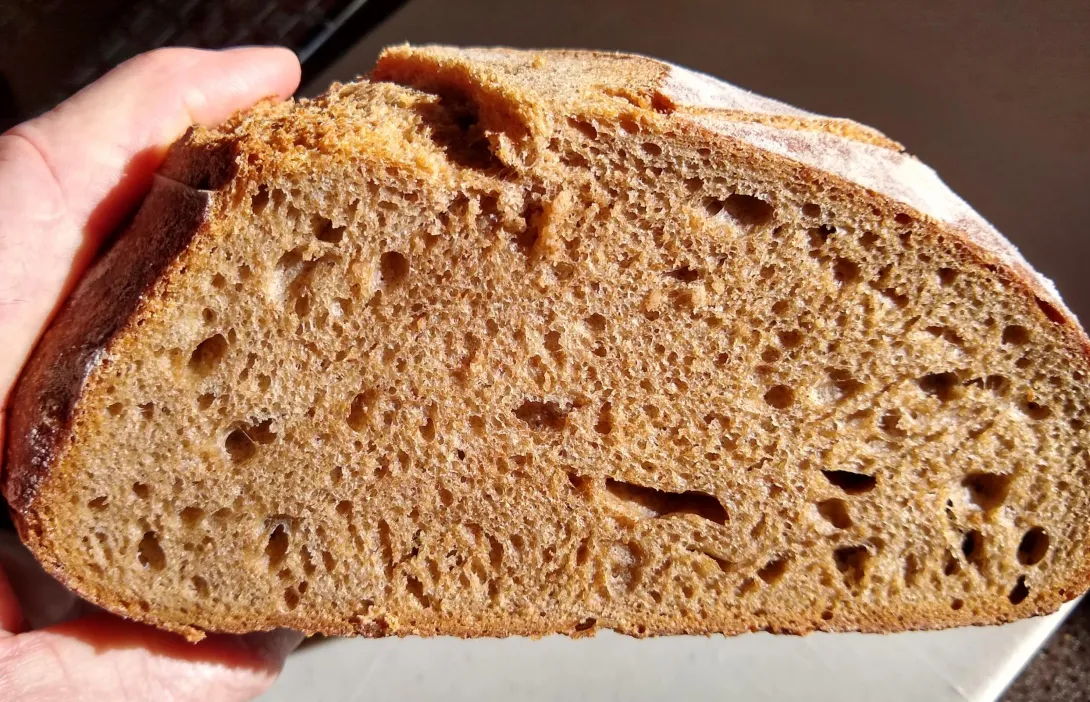
Most of my past failures have been due to over proofing while I'm trying to build gluten but why have I been trying to get these two separate processes to finish at the same time when it apparently isn't necessary?
I have interesting results from a long autolyse experiment. I've been baking 70% WW / 30% BF two loaf, 1000g flour batches and tried the process below.
The 1st evening when I mixed the sourdough pre-ferment (about 220-230g) I separately added 600g water to the 700g WW and let it autolyse overnight. In the morning a poke indicated already good gluten development. I mixed that with the remaining 130g water (with salt dissolved) and the 300g bread flour. Then after a couple of stretch-fold cycles did the pre-shape, rest, final shape, basket, and fridge overnight for a morning bake.
This has worked well several times now. Once you've got the gluten development it's not going anywhere, so if I only have to worry about proofing then I can start the final proof earlier and thereby leave plenty of fuel for the oven spring. This simplifies the process and I'm very happy with the crumb and overall results as the picture shows (it did have a nice ear that I hacked off. Forgive me).
Can you provide details on:
- what type of whole wheat flour are you using?
- when did you add the leaven? In the morning with the salt and remaining water?
- how long your bulk fermentation was after the autolyse?
Thanks!
This is the thrust of Peter Reinhart's popular epoxy-style, as discussed in Whole Grain Breads, and of course, similar approaches by many other bakers. With a little bit of planning, you can largely replace kneading with time. He writes:
It is then combined in the final mix, often with a fairly large percentage of prefermented flour. In the case of whole grain baking, using salt is advisable for any extended autolyse/saltolyse to reduce effects of proteolysis (dough puddles and post-shaping lesions). Nearly all of the "soakers" in WGB use salt. I don't recall that being discussed explicitly, but presumably it is for this reason. I spent much of the summer away from home baking with pre-milled bread flour where a short autolyse or mix all works just fine, and after returning to my mill and whole grain baking this Fall, I continued using a standard but extended autolyse for the thirstier whole grain flour I was milling. A recent discussion with suminandi and a recent related post by Abe -- which I can't find but points out a long autolyse can weaken dough and mentions this article -- made me revisit this. Adding salt to the a long autolyse/saltolyse/soaker has noticeably improved dough strength in all of my recent whole grain bakes, at the expense of a slightly harder final mix. I'm fairly new to baking, but wanted to post this in case you found it similarly helpful.
Again, I think this is largely true, but I don't think gluten development in and of itself is a sufficient trigger to transition from bulk fermentation to shaping and final proofing. You still want sufficient dough strength to support proper shaping. I found this recent discussion about evaluating bulk fermentation and mwilson's framing of dough strength as internal pressure (not just gluten formation) to be useful for thinking about requirements of final shaping. Both of these posts lined up in a way that I believe has improved my recent bakes. This is more apparent with an extended saltolyse, where you end up with strong gluten development immediately after mixing. I suspect shaping that early won't produce the same loaf structure or crumb that a loaf shaped after developing more strength (or puffiness) will, although I haven't tried shaping so early. It would be an interesting experiment!
That looks like a nice loaf of bread!
I too have been employing an overnight (extended) saltolyse for sometime. At first it was for convenience because I wanted to do an overnight levain build and unless I did the autolyse overnight I wouldn’t have enough time to do an autolyse at all. Then wanting to slow down the enzymes in the flour decided to add the salt to the autolyse so thus it is a saltolyse. I have been extremely pleased with the loaves I’ve baked since using a saltolyse. The dough in the morning has a very good windowpane so further dough development is directed at organizing the gluten and building structure as the dough ferments and builds internal pressure as a balloon would as you fill it with gas.